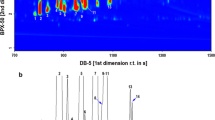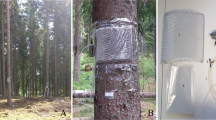Summary.
Stem volatile extracts from ten trees that are sympatric with the western pine beetle, Dendroctonus brevicomis LeConte (Coleoptera: Curculionidae) were assayed by gas chromatographic-electroantennographic detection analysis (GC-EAD). The extracts were from the primary host, ponderosa pine, Pinus ponderosa Dougl. ex Laws. (Pinaceae); two nonhost angiosperms, California black oak, Quercus kelloggii Newb. (Fagaceae), and quaking aspen, Populus tremuloides Michx. (Salicaceae); and seven nonhost conifers, white fir, Abies concolor (Gord. & Glend.) Lindl. ex Hildebr. (Pinaceae), incense cedar, Calocedrus decurrens (Torr.) Florin (Cupressaceae), Sierra lodgepole pine, P. contorta murrayana Grev. & Balf. (Pinaceae), Jeffrey pine, P. jeffreyi Grev. & Balf. (Pinaceae), sugar pine, P. lambertiana Dougl. (Pinaceae), Douglas-fir, Pseudotsuga menziesii (Mirb.) Franco (Pinaceae), and mountain hemlock, Tsuga mertensiana (Bong.) Carr. (Pinaceae). Sixty-four compounds were identified from the ten trees, 42 of which elicited antennal responses in D. brevicomis, usually in both sexes. In addition, several synthetic compounds, including a number of the antennally-active compounds from the extracted trees and some bark beetle pheromone components, elicited antennal responses in a manner similar to that observed with the extracts. Of the antennally-active compounds known to be present in trees sympatric with D. brevicomis, only geraniol was unique to its host. Four antennally-active compounds were found in the host and in other conifers; five compounds were found only in nonhost conifers; eight compounds were found in either or both of the nonhost angiosperms; eight compounds were found in either or both of the angiosperms and in nonhost conifers, but not in the host; and 19 were found in both the host and in angiosperms and/or nonhost conifers. Several bark beetle pheromone components were found in the stem volatile extracts. Conophthorin was identified from both nonhost angiosperms; exo-brevicomin was identified in A. concolor; verbenone was identified from a number of nonhost conifers; and chalcogran was identified from P. tremuloides. The number of nonhost volatile chemicals that D. brevicomis encounters and is capable of detecting, and the diversity of sources from which they emanate, highlight the complexity of the olfactory environment in which D. brevicomis forages. This provides a basis for further work related to chemically-mediated aspects of foraging in this insect and perhaps other coniferophagous bark beetles, and highlights the need to consider foraging context in the design and implementation of semiochemical-based management tactics for tree protection.
Similar content being viewed by others
Author information
Authors and Affiliations
Corresponding author
Rights and permissions
About this article
Cite this article
Shepherd, W.P., Huber, D.P.W., Seybold, S.J. et al. Antennal responses of the western pine beetle, Dendroctonus brevicomis (Coleoptera: Curculionidae), to stem volatiles of its primary host, Pinus ponderosa, and nine sympatric nonhost angiosperms and conifers. Chemoecology 17, 209–221 (2007). https://doi.org/10.1007/s00049-007-0378-8
Received:
Accepted:
Published:
Issue Date:
DOI: https://doi.org/10.1007/s00049-007-0378-8




